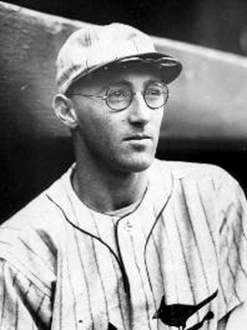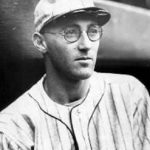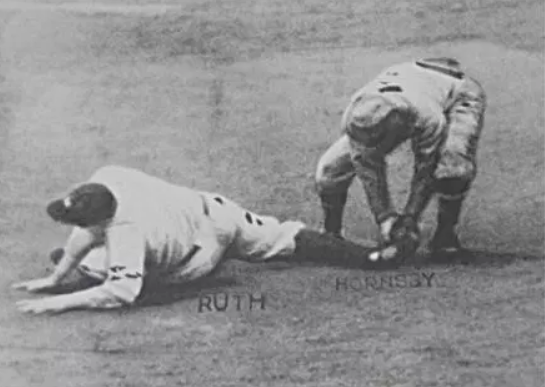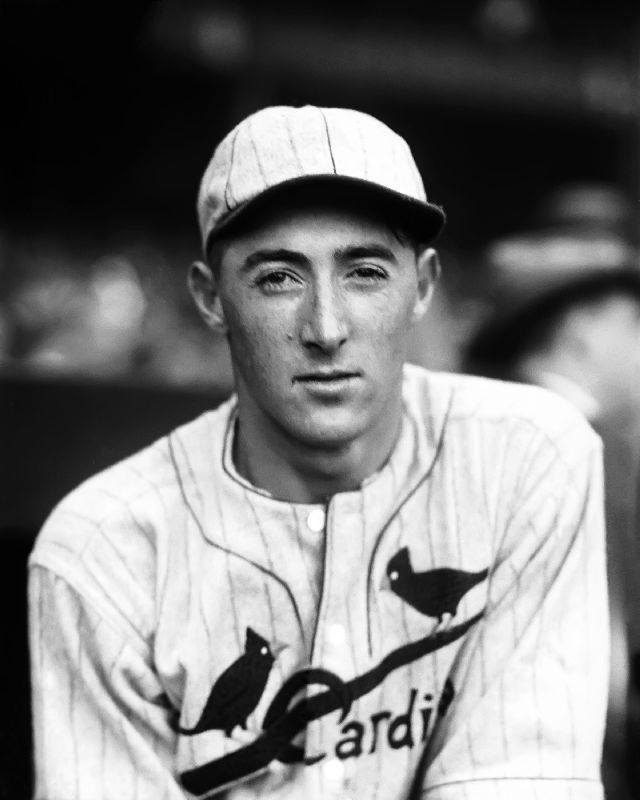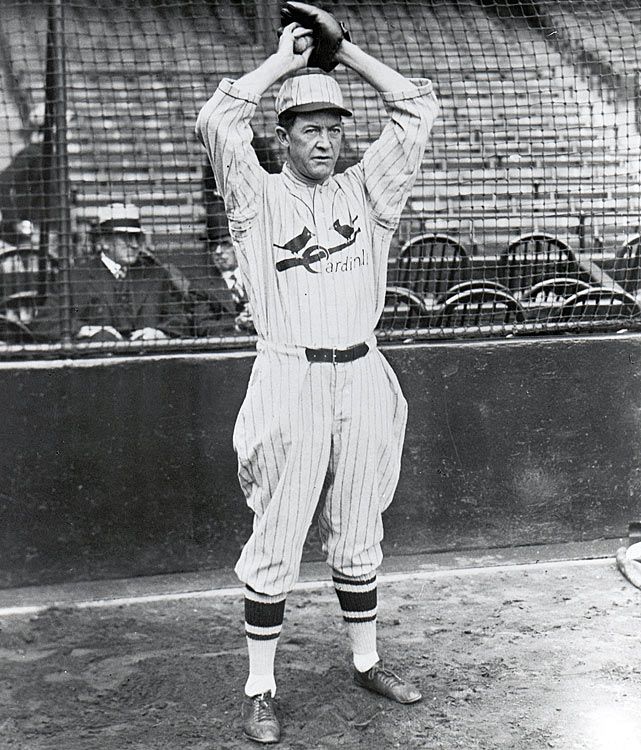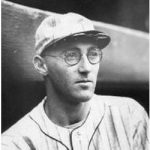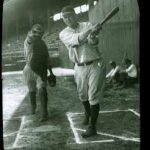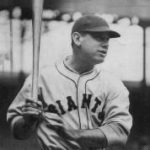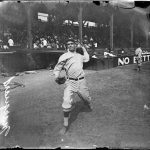Chick Hafey Stats & Facts
VINTAGE BASEBALL MEMORABILIA
Chick Hafey
Position: Outfielder
Bats: Right • Throws: Right
6-0, 185lb (183cm, 83kg)
Born: February 12, 1903 in Berkeley, CA us
Died: July 2, 1973 in Calistoga, CA
Buried: Holy Cross Catholic Cemetery, St. Helena, CA
High School: Berkeley HS (Berkeley, CA)
Debut: August 28, 1924 (6,041st in major league history)
vs. CHC 4 AB, 0 H, 0 HR, 0 RBI, 0 SB
Last Game: September 30, 1937
vs. CHC 1 AB, 0 H, 0 HR, 0 RBI, 0 SB
Hall of Fame: Inducted as Player in 1971. (Voted by Veteran’s Committee)
View Chick Hafey’s Page at the Baseball Hall of Fame (plaque, photos, videos).
View Player Info from the B-R Bullpen
View Player Bio from the SABR BioProject
Relatives: Cousin of Bud Hafey, Tom Hafey
Chick Hafey made his Major League debut on August 28, 1924, he was the 6,041st in major league history, vs. Chicago Cubs he went 0-4
Nine Players Who Debuted in 1924
Charlie Gehringer
Al Simmons
Earle Combs
Freddy Lindstrom
Chick Hafey
Red Ruffing
Hughie Critz
Max Bishop
Glenn Wright
The Chick Hafey Teammate Team
C: Ernie Lombardi
1B: Jim Bottomley
2B: Rogers Hornsby
3B: Pepper Martin
SS: Leo Durocher
LF: Kiki Cuyler
CF: Taylor Douthit
RF: Harry Heilmann
SP: Jesse Haines
SP: Pete Alexander
SP: Paul Derringer
SP: Burleigh Grimes
RP: Dazzy Vance
M: Branch Rickey
Notable Events and Chronology for Chick Hafey Career
When Charles Hafey first caught Branch Rickey’s eye in the spring of 1923, it was a case of mistaken identity. Hafey was in the Cardinal camp as a right-handed pitcher, but Rickey saw him in the batting cage, and after he sped down the first base line later that day, the St. Louis manager was certain he had the makings of an outfielder. As he was about so man other players, Rickey was right about Hafey. “Chick” won a batting title and finished in the top ten in homers six times on his way to a career .317 mark from the right side of the plate. Helped in large part by former teammate Frankie Frisch’s recommendation, in 1971 he was elected to the Hall of Fame, and remains one of the most controversial members of that select club.
Biography Chick Hafey
One of the hardest-hitting righthanded batters in the game, Hafey had his best years with the Cardinals. It is difficult to assess how great Hafey might have been if not for his ill health, poor eyesight, and constant salary disputes. Hafey had a chronic sinus condition that required several operations and affected his vision. After beanings in 1926, a doctor advised him to wear glasses, and since his eyesight would vary from day to day, he used three different pairs. He became one of the first bespectacled outfielders.
Hafey was known for his rifle arm and his line drives. He started as a pitcher, but switched to everyday play under Branch Rickey. He was regarded by many as the second-best righthanded hitter of his day, behind Rogers Hornsby. A quiet man, he was somewhat overshadowed by the more colorful individuals who played on the Cardinals’ championship teams of the 1920s and early 1930s.
In 1929 Hafey tied a National League record with ten successive hits. After batting .336 in 1930, he held out for $15,000, reporting ten days late to spring training. He eventually signed for $12,500, but Rickey fined him $2,100 for not being in playing shape. Hafey responded by winning the 1931 batting title with a .349 mark. He then demanded $17,000 for 1932, including a return of the $2,100. Rickey offered him $13,000, a raise of just $500. Incensed, Hafey drove home to California and waited until April 11, when he found out he had been traded to the Reds for Bennie Frey, Harvey Hendrick, and $50,000; Rickey had Joe Medwick waiting in the wings.
Hafey was happy to join the Reds, who paid him $15,000, though they were a last-place club. Battling the flu and his sinus condition, Hafey played just 84 games, but hit .344. In 1933 he hit .303, making the first All-Star team (and getting the first hit in All-Star history, a single in the second inning), but his health was not good. His last campaign as an everyday player was 1934. He hurt his shoulder in 1935, but on May 24, played in the first-ever regular season night game. The evening’s dampness aggravated his sinuses. He saw the future of night baseball, and realized his career was ending. He retired, sitting out the rest of 1935 and all of 1936, but attempted a comeback in ’37, playing in 89 games. He then quit for good, at the age of 34. He was elected to the Hall of Fame 34 years later by the Veterans Committee.@ET-DC@eyJkeW5hbWljIjp0cnVlLCJjb250ZW50IjoicG9zdF90YWdzIiwic2V0dGluZ3MiOnsiYmVmb3JlIjoiTGVhcm4gTW9yZSBhYm91dCB0aGUgdGVhbXMsIHBsYXllcnMsIGJhbGwgcGFya3MgYW5kIGV2ZW50cyB0aGF0IGhhcHBlbmVkIG9uIHRoaXMgZGF0ZSBpbiBoaXN0b3J5IC0gLSAtIC0gLSAtIC0gIiwiYWZ0ZXIiOiIiLCJsaW5rX3RvX3Rlcm1fcGFnZSI6Im9uIiwic2VwYXJhdG9yIjoiIHwgIiwiY2F0ZWdvcnlfdHlwZSI6InBvc3RfdGFnIn19@
Factoids, Quotes, Strange Things
Best Season, 1931
Hafey led the NL in batting (.349), and OBP (.404). Though he missed several weeks to injury, he scored 94 runs and drove in 95 in 450 at-bats. The tight batting race was one of the most famous ever.
Post-Season Appearances
1926 World Series
1928 World Series
1930 World Series
1931 World Series
Alternative Bio
In the early 1920s, the Cardinals, under the leadership of Rickey, were just beginning their expansive farm system, the first in the major leagues. Hafey was the first star of that system, and by 1925 he was in the Cardinal outfield, hitting .302. Over the next six seasons with St. Louis, Hafey fell below the .300 mark just once. A soft spoken, shy man, Hafey batted in the middle of the lineup, replacing the traded Rogers Hornsby after the ’26 season as the Cards big slugger.
During that 1926 season Hafey was hit by pitched balls on four occasions. He continually complained of headaches and sinus trouble throughout the season. Dr. Robert Hyland advised him to wear glasses, and Hafey became the first star to wear them on a regular basis. In fact, he had three different pairs because his eyesight varied so much. In addition, over the next few seasons he had numerous operations to address his chronic sinus problems. Rickey and John McGraw both went on record that had Hafey not been plagued with the health problems, he may have been the game’s best right-handed hitter. As it turned out – he was very good.
In 1931, the Cardinals won their second straight NL pennant, and Hafey enjoyed his finest season. But it didn’t started out that way. Chick began the season in a contract holdout, finally signing just prior to the start of the season. But Rickey demanded that Hafey prove that he was fit to play. Since Hafey had missed spring training, this meant he was kept on the bench for the first few weeks of the season. Later his chronic sinus problems flared up and through June 4th he had batted just 65 times.
The early summer months were not kind to Chick, on July 16th his batting average was .281, well below the league norm for an outfielder. At that same point Chuck Klein was leading the league at .359, and Bill Terry was hitting .348. Over the next four months Hafey went on the greatest tear to win a batting title in history.
By August 6th Hafey had crept up to .316, still 27 points behind Chuck Klein and 21 behind Terry. On September 3rd he was still 20 points behind the leader – know Terry – with Klein and teammate Jim Bottomley in his way as well. There were 31/2 weeks left in the season.
The following week Hafey batted just .273, but actually gained on the new leader, the Phillies Klein, who led him by 18 points. From the 11th to the 17th Hafey enjoyed 6 multiple hit games, four of them in back-to-back doubleheaders. That left the four NL hitters in a remarkable race for the title. Many historians forget that Klein was in the thick of the race – as of the 17th, Terry was at .3424, Bottomley at .3418, Klein .3415, and Hafey .340.
A doubleheader on the 19th dropped Klein behind as he went 1-for-8. On the same day Terry went 1-for-5 and Bottomley suffered a hitless day in five official trips to the plate. Hafey went 3-for-3, and led the league for the first time, at .347. The next two days he went 5-for-7, but Terry went 8-for-11, keeping him right behind Hafey.
The next few days Klein was the only one to play, going 0-for-4 on the 24th, essentially eliminating himself. The defending champ Terry took a few days off, while Hafey went 2-for-5 on the 26th and Bottomley got back in it with a 3-for-4 performance. Hafey stood at .3506, Sunny Jim was .3449, and Terry was resting at .3492, both just slightly behind Hafey.
The final day of the regular season was meaningless in the standings, the Cards having clinched the title weeks prior. Hafey and Bottomley played the full doubleheader against Klein’s Phillies. Klein went a harmless 0-for-8, finishing at .337, good for fourth in the NL.
Hafey went 0-for-4 in the opener while Terry went 1-for-4 in his final game. Sunny Jim banged out two hits in four trips, moving him to within a point of Hafey who now trailed Memphis Bill by a point! The three future Hall of Famer players were two points apart.
A few hits by either of the Cardinals in the finale of their twinbill would snatch a second straight batting title away from the Giant first baseman. And that’s what they did. Hafey laced two hits and Bottomley did the same. But it was Hafey, with a single in his last trip, who won the crown. His final average was .3489, Terry came in second at .3486, and Bottomley, robbed of a hit his third time up – finished third at .3482. Hafey, who was hitting just .283 through his first 45 games, hit .385 over the last 77 to win his only batting title.
A classic batting race – the closest among three players ever – was over. The most unlikely fellow had won it – Chick Hafey – the holdout with bad eyes, a bum arm, and a front office that didn’t really want to pay him.
Where He Played: Left field, though Cincinnati threw him into center late in his career.
Feats: Hafey slammed ten consecutive hits in 1929, tying a National League record.
Transactions
April 11, 1932: Traded by the St. Louis Cardinals to the Cincinnati Reds for Harvey Hendrick, Benny Frey, and cash.
Replaced
Ray Blades
Replaced By
Sammy Byrd
Best Strength as a Player
The guy could flat-out hit.
Largest Weakness as a Player
Inability to stay healthy. Hafey suffered from chronic sinus problems and poor vision which cost him quite a bit of playing time.

